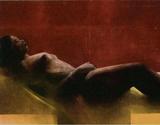

Contributed photos
LEFT: 'Repose' by George Rodney.
RIGHT; George Rodney, a painter who believes in giving life to his visions.
Michael Robinson, Gleaner Writer
Fifty-one years ago, when George Rodney started out at the Cultural Training Centre on North Street, Kingston, he couldn't possibly have known where the journey would take him, but he knew he wanted to paint. At the time, the institution that eventually became the Edna Manley College (EMC) was a part-time school.
With Osmond Watson and Alexander Cooper among his contemporaries, Rodney attended from 4:30 to 9:00 in the evenings. He studied drawing, painting and commercial art - now more commonly known as graphic design.
Art school in the US
A couple years later, he left Jamaica and spent four years at the Art Students League in New York. The league is an artist-run school which has been operating since 1875. While at the league, Rodney says he concentrated solely on painting and drawing the figure. "I would go out into the park and do landscapes on my own," says Rodney. He found Fort Tryon Park particularly quiet and peaceful. "I liked going up there with my easel and setting it up in the park and sketching," he says.
On his return in 1963, Rodney took a job at Jamaica Broadcasting Television (JBC TV) as a graphic artist, a post he held for the next nine years. "I was always painting," he explains, "but I had to have a job to support myself. That also applies to young artists today, because you can never start out wholly concentrating on art.
"Nowadays it's better for the young artists, because more Jamaicans are supporting art," continues Rodney. "But in my time, I was never sure when I would sell anything so I just did it for the love of it. I wanted to become a genuine painter."
To that end, he followed a career path that moved from full-time work to part-time teaching at the Cultural Training Centre, around the time of the transition to Arthur Wint Drive, where it became the Jamaica School of Art. Some time in 1981, the husband and father of one stopped teaching and delved full-time into the practice of art.
Surrounded by paintings in his Kencot studio, it's hard to imagine this luminary of Jamaican art having a tough time creating, but he admits that, even now, painting challenges him. "It has always been a struggle you know ... painting, drawing ... always a struggle with it, but I managed to continue and this is where I am now."
Where he is now is a long way from his first exhibition in 1964. The two-man exhibit, which also featured work by Maurice Chin, was mounted at Kingston's prestigious Hills Galleries. His first solo show was at Eugene Hyde's John Peartree Gallery. Since then, Rodney has exhibited in countries all over the world, including Italy, Venezuela and San Salvador. He has won numerous national medals and awards, not the least of which being the Silver Musgrave Medal from the Institute of Jamaica. As a teacher, he must have influenced countless artists as they made their way through EMC. As a painter, his dedication to the craft is simultaneously humbling and inspiring.
In person, his soft-spoken manner is disarming. It's obvious that, despite his many professional achievements, Rodney still sees himself first and foremost as a painter, with many of the same concerns as when he first took up the brush half a century ago.
The challenge, he says, comes from starting out at the same point - representation - and trying to present it in a different light each time. "One never knows how the painting is going to end up," says Rodney. He describes representation as "a means to an end". He paints mostly with acrylic paints these days, as he finds the medium superior in many ways to oil.
Focal points
His paintings usually have objects as the focal point. He'll start with the figure, a still life or a landscape, and then depart from it. Some time in the late '70s, his commercial training surfaced as a stylistic influence in the work. Hard-edged lines, borne from an aesthetic honed on cut-and-paste techniques (which were the basis of graphic art in the days before Photoshop) have become part of Rodney's signature style. His visual analysis of the behaviour of light is a cross between cubism, impressionism and a laser beam.
Interestingly, although he started out drawing and painting figuratively and moved into abstraction, where the literal representation was all but obliterated, there seems to be a re-emergence of the figure in his most recent works. It's as though he has come full circle.
"It's always a search," he admits. The painting dictates its own direction to him, and even he doesn't know where he's going to end up. "At some point during that struggle," he offers, "you get the feeling that you're on the right track and you shouldn't stray too far from what you have there."
When Rodney started painting, the Jamaican art scene was very active although, as he puts it, there wasn't as much financial support as there is now. "We were quite enthusiastic," he says, "and we were in it for the love of it, not for money."
The artists responsible for the modern era of Jamaican art, including Edna Manley, were creating from a pure impulse. They were producing art simply because it was inside them. For Rodney, not much has changed. Although he no longer has to worry about his pieces selling, his motivation is still the same. His role as artist is what it has always been: to give life to his visions, thereby keeping the creative cycle alive.

